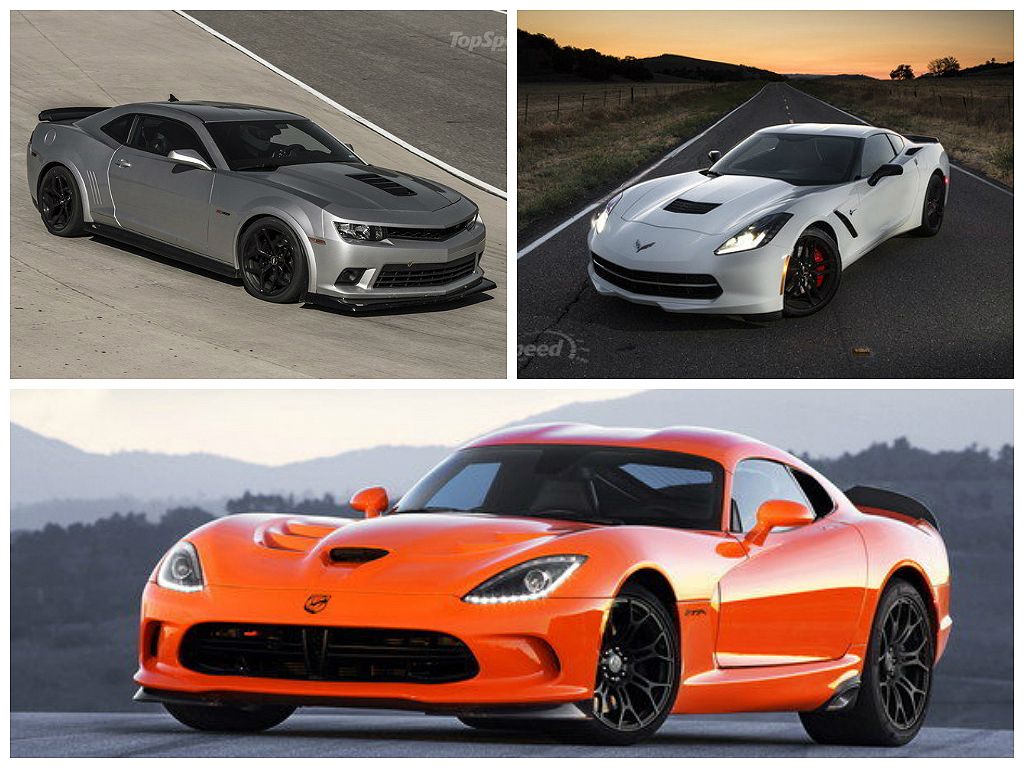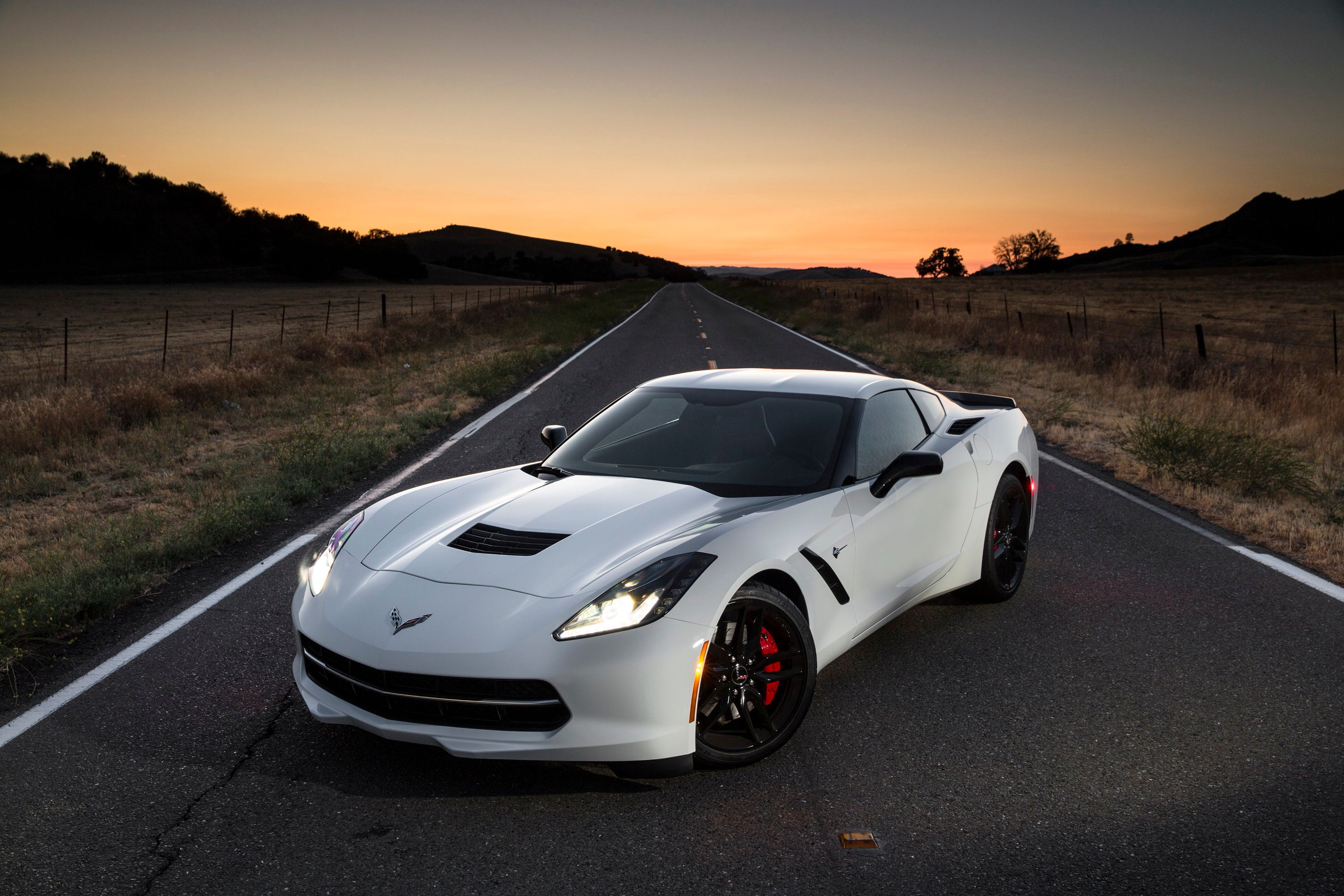Forget what they say, these are the glory days of muscle.->ke507 Sure, carburetors and glass packs are out, but direct fuel injection, variable-flow exhaust pipes, and computers have revolutionized the way modern street and track fighters do battle. We’ve pitted three of the most purpose-built machines together to see not only which car would win on the track, but which car would be the easiest to live with on a daily basis.
The competitors all hail from the U.S. of A. and sport snarling engines making huge amounts of power, all sent to the rear wheels though a manual transmission. They’re brash and unapologetic, unforgivably fast, and diabolically cool. Though they’ve all got the performance creds, do they have what it takes to impress the missus enough for a purchase to occur?
Our three contenders are the SRT (now back to Dodge) Viper, the Chevrolet Corvette, and the Chevrolet Camaro Z/28.
In order for this to be a fair fight, we’ve got to price these cars correctly. Starting with the Viper, its base MSRP is comes in at $102,485 -- well over that of the Vette and Z/28 -- but considering the hard time Dodge has had selling the sultry snake, there are dealer incentives to be had. According to a few price-checking websites, a 2014 base Viper can be had in the mid $90,000 range.
The Camaro Z/28, on the other hand, starts out at $73,300 -- but that’s bare-bones stock without air conditioning. Another $1,150 makes the car livable in the summertime. Its total cost comes to $76,150 after destination and the gas-guzzler tax.
The Vette represents the bargain of the bunch, coming in at $70,985 in its top-line, 3LT trim fitted with the Z51 Performance Package, Magnetic Ride, Performance exhaust, and Competition Sport seats. It may be the highest equipped here, but will its least-powerful engine be able to keep up?
Click past the jump to find out.
Exterior Appeal
I always say looks are subjective and everyone has their own opinion. What I say is a beautiful car, someone else may strongly disagree. That said, all three of these contenders are good-looking cars with each having their own distinct personality. The Viper is easily the most menacing of the bunch with its long, sculpted hood complete with deep vents and center bulge. The Viper’s gaping mouth, large side gills, side-pipe exhausts, and voluptuous rear end bark just as loud as the V-10 engine bites.
The Corvette shares a similar exterior architecture as the Viper, though it’s much more subdued. Its body still has plenty of functional vents and aero pieces adorning its every side, but they don’t yell quite as loudly as the Viper. For some folks, that’s a good thing. Being over ostentatious with their ride makes for overly jealous neighbors. Functionality wise, the Stingray offers greater rearward visibility than the snake and is much more pleasant to drive with its dual-mode exhaust pipes routing sound rearward rather than just under the door.
The Camaro Z/28 is in a league all its own in this trio. With the most subtle looks of the bunch, the Z/28 could be mistaken for its $25,000 base-model brethren by the casual observer. However, those who know anything about anything automotive know the Z/28 is one of the most highly talked-about Chevys of recent history. Its large front splitter, low stance, tall rear spoiler, and wide fender extensions give away the Z/28’s powerful secrets. What’s more, the Z/28 boasts the widest tires currently rolling down the road with a 305-aspect ratio at all four corners.
Interior Ingenuity
All three cars boast massive amounts of performance capabilities, so the cockpit must work well as a command center. The Viper’s interior space is classy integration of new technologies and old-school viper charm from the car’s early beginnings. Chrysler’s Uconnect 8.4 system finds its way into the center console and gauge cluster, helping the driver stay connected with navigation and a customizable gauge display. The flat-bottom steering wheel and red stitching across the dash help remind the driver of the car’s very sporty intentions.
The Corvette is much like the Viper in terms of technology integration. It features the large Chevy MyLink infotainment system and digital center gauge cluster. It too is customizable with different gauges depending on the different drive modes. The interior is rather tight on space, so hitting the gym before hitting the road might be a necessity. The Stingray’s fit and finish is somewhat better than the Viper and it is a more comfortable place to be over several hundred miles. It’s also significantly quieter than the Dodge.
Of course, the Z/28 has a large leg up on the Viper and Vette in terms of interior usefulness with its two extra seats. They certainly aren’t intended to hold adults for long periods of time, but they work well in a pinch and are fine for the kids. Conversely, the Z/28 is the most spartan in terms of amenities. Navigation, an upgraded audio system, a large driver information center, and leather seats are all non-existent. Air conditioning and the six-speaker radio is a $1,150 option. What you get are Alcantara-covered Recaro bucket seats with a small bit of Alcantara along the dashboard. Minimal sound deadening means the cockpit is loud and likely hot after a few hard laps. But get past the chintzy plastic and lack of options, and the Z/28 is an all-out performance machine.
Performance of the Pack
In one degree or another, all three cars are geared for high-performance driving that can only be fully explored on a racetrack. The Viper brings the biggest gun to the showdown; an 8.4-liter V-10 making 640 horsepower and 600 pound-feet of torque. That’s routed through a six-speed manual transmission to the massive, 355-series rear rubbers. The Stingray brings the smallest, yet most technologically-advanced engine to the trio. The Vette’s LT1 is a 6.2-liter V-8 featuring direct injection, variable valve timing, and active fuel management. The setup is good for 460 horsepower and 465 pound-feet of torque (five horses and pound-feet more than the non-performance exhaust-equipped Vettes) and is controlled by a seven-speed manual transmission. The Z/28 comes equipped with a 7.0-liter V-8, similar to the one found in the previous generation Corvette Z06. It cranks out 505 horsepower and 481 pound-feet of torque. A six-speed Tremec manual transmission keeps the Chevy small-block in its powerband while the massive 305-series tires put the power to the pavement.
Crunching the performance numbers, the Viper nails the victory to 60 mph, doing it only 3.4 seconds on its way to a quarter-mile run of only 11.6 seconds. The Vette isn’t far behind, hitting 60 mph in 3.9 seconds and the quarter mile in 12.2 seconds. The Z/28 takes 4.1 seconds to hit 60 mph and 12.4 seconds to get through the quarter-mile. While 4.1 seconds to 60 is the slowest time of the bunch, it’s still nothing to be ashamed of.
When it comes to cornering, however, the finishing order gets shaken up. Vette takes the lead, pushing 1.11 lateral Gs while the Viper is a close second at 1.10. Again, the Z/28 comes in third, but at a still-respectable 1.06 Gs.
Livability
For those folks looking for a two-door supercar like the three American bruisers here, they’ll need to evaluate their priorities. What takes the top slot – comfort, all-out track performance, price, exclusivity, looks, or brand? For most, the price and brand will have much to do with the decision.
For the guy with a big budget who wants the look-at-me ride with a gnarly character, the Viper is the right choice. For the guy wanting the most exclusive power-player, the Z/28 is on tight lockdown. (All the 2014 models are already sold out.) And for the guy who wants a good all-around car with high performance but that doesn’t beat him up with every bump, the Corvette Stingray makes a great choice. Especially considering the Z51 Performance Package’s optional Magnetic Ride Control that offers driver-selectable ride characteristics, the Vette is a more multifaceted machine.
Beyond the dynamic performance metrics of each car, they each have certain querks that make them more or less difficult to live with on a daily basis. While it does seem unlikely the Viper or Z/28 would serve as someone’s everyday vehicle, the possibility exists. Of the three, the Z/28 offers the most functionality with its four seats and decent trunk space. Its lack of an infotainment system is a real detractor, but those aren’t a true necessity.
Conclusion
All three cars offer excellent performance on the track and serve well as eye-catchers. While these cars will likely serve out their days as weekend toys and track day cars, for some buyers, their road manners and livability will play a huge role in whether they’re purchased or not. Therefore, we’ve got to crown a winner.
3rd Place – SRT Viper
2nd Place – Chevrolet Camaro Z/28
1st Place – Chevrolet Corvette Z51


